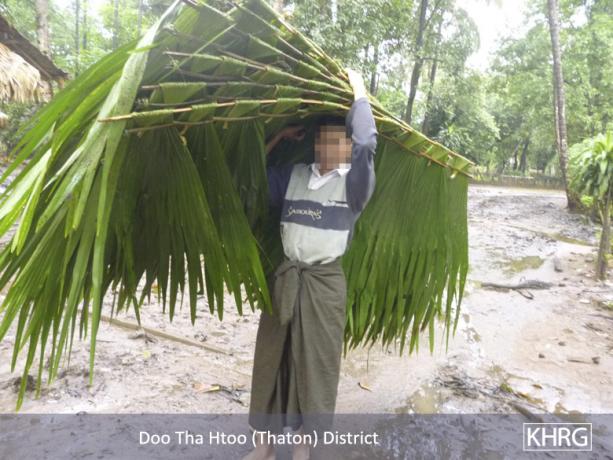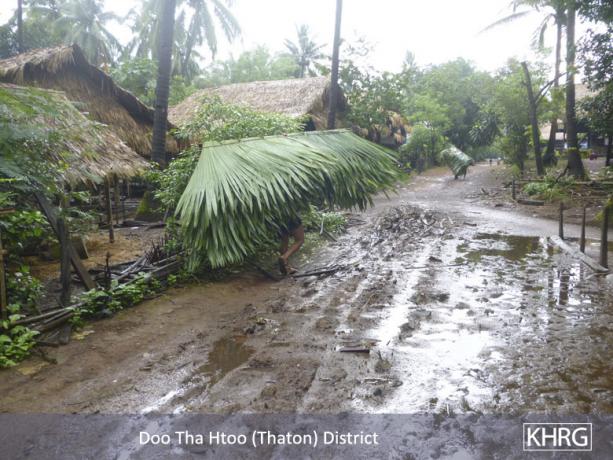


The first photo, taken by a community member in September 2012 in Thaton District, shows D--- village leaders discussing a Tatmadaw order
to make and transport thatch to Lay Kay army camp. The other photos, taken by a community member in September 2012 in Thaton District,
show D--- villagers sorting and transporting thatch shingles for the Tatmadaw's Lay Kay army camp. According to the community member, it
is unusual for the monsoon season to continue into September, and the order was given for the villagers to transport thatch because the army
camp required repair on account of rain damage. [Photos: KHRG]
KHRG continued to receive reports of demands for forced labour by Tatmadaw soldiers in the Lay Kay area in Bilin Township, Thaton District throughout the first half of 2012, however, as of September 2012, the forced labour is reported to have ceased altogether.
During April 2012, residents of B---, D---, G---, H---, R--- and K--- villages in Bilin Township faced demands from Tatmadaw Light Infantry Division (LID) #44 for building materials, including 5,000 bamboo poles and more than 20,000 thatch shingles. LID #44 soldiers also used villagers to perform unpaid set tha[1] (messenger) service at Lay Kay army camp in April 2012.According to the community member who submitted this information, the incidents affected approximately 721 villagers from these six villages. Thirty-three representatives from the afflicted villages submitted accounts of abuse committed by LID #44 to the International Labour Organization (ILO) on July 11th 2012 through a community member trained by KHRG.
Tatmadaw soldiers again ordered villagers from D--- village to provide thatches for barracks repair at Lay Kay army camp during a period of heavy rain in September 2012.
On April 29th 2013, the same community member trained from Bilin Township reported that the demands for forced labour from Lay Kay army camp had ceased and shares villagers’ views regarding what had brought about this change:
"After we submitted forced labour information to the International Labour Organization in July 2012, the forced labour happened only one time, when the Tatmadaw ordered D--- villagers to provide thatch for repairing their camp in September 2012. Since then (September 2012), the forced labour has not happened again up until now. Based on villagers’ views, the forced labour has stopped because of three possible reasons: (1) forced (labour) has stopped after we submitted the forced labour incident to ILO; (2) forced labour has stopped after the Karen National Union [KNU] and Burma government signed the ceasefire agreement;[2] and (3) forced labour has stopped for the reason that Burmese soldiers now dare to go and cut down trees and bamboo from the forest by themselves [because soldiers are no longer afraid of possible Karen National Liberation Army ambushes]."
KHRG has not received any reports from community members of forced labour occurring in Lay Kay area, Bilin Township, Thaton District, since the end of September 2012.
 ,
,  ,
,  ,
, 
These photos, taken by a community member in September 2012 in Thaton District, show D--- villagers sorting and transporting thatch shingles for the Tatmadaw’s Lay Kay army camp. According to the community member, it is unusual for the monsoon season to continue into September, and the order was given for the villagers to transport thatch because the army camp required repair on account of rain damage. [Photos: KHRG]
KHRG continued to receive reports of demands for forced labour by Tatmadaw soldiers in the Lay Kay area in Bilin Township, Thaton District throughout the first half of 2012, however, as of September 2012, the forced labour is reported to have ceased altogether.
During April 2012, residents of B---, D---, G---, H---, R--- and K--- villages in Bilin Township faced demands from Tatmadaw Light Infantry Division (LID) #44 for building materials, including 5,000 bamboo poles and more than 20,000 thatch shingles. LID #44 soldiers also used villagers to perform unpaid set tha[1] (messenger) service at Lay Kay army camp in April 2012.According to the community member who submitted this information, the incidents affected approximately 721 villagers from these six villages. Thirty-three representatives from the afflicted villages submitted accounts of abuse committed by LID #44 to the International Labour Organization (ILO) on July 11th 2012 through a community member trained by KHRG.
Tatmadaw soldiers again ordered villagers from D--- village to provide thatches for barracks repair at Lay Kay army camp during a period of heavy rain in September 2012.
On April 29th 2013, the same community member trained from Bilin Township reported that the demands for forced labour from Lay Kay army camp had ceased and shares villagers’ views regarding what had brought about this change:
"After we submitted forced labour information to the International Labour Organization in July 2012, the forced labour happened only one time, when the Tatmadaw ordered D--- villagers to provide thatch for repairing their camp in September 2012. Since then (September 2012), the forced labour has not happened again up until now. Based on villagers’ views, the forced labour has stopped because of three possible reasons: (1) forced (labour) has stopped after we submitted the forced labour incident to ILO; (2) forced labour has stopped after the Karen National Union [KNU] and Burma government signed the ceasefire agreement;[2] and (3) forced labour has stopped for the reason that Burmese soldiers now dare to go and cut down trees and bamboo from the forest by themselves [because soldiers are no longer afraid of possible Karen National Liberation Army ambushes]."
KHRG has not received any reports from community members of forced labour occurring in Lay Kay area, Bilin Township, Thaton District, since the end of September 2012.